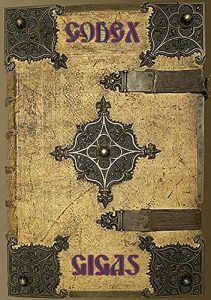Perfectly scanned copy of original medieval manuscript.
The Codex Gigas is the largest extant medieval manuscript in the world. It is also known as the Devil's Bible because of a large illustration of the devil on the inside and the legend surrounding its creation. It is thought to have been created in the early 13th century in the Benedictine monastery of Podlažice in Bohemia. It contains the Vulgate Bible as well as many historical documents all written in Latin.
According to one version of a legend that was already recorded in the Middle Ages, the scribe was a monk who broke his monastic vows and was sentenced to be walled up alive. In order to forbear this harsh penalty he promised to create in one single night a book to glorify the monastery forever, including all human knowledge. Near midnight he became sure that he could not complete this task alone, so he made a special prayer, not addressed to God but to the fallen angel Lucifer, asking him to help him finish the book in exchange for his soul. The devil completed the manuscript and the monk added the devil's picture out of gratitude for his aid.
About half of the codex consists of the entire Latin Bible in the Vulgate version, except for the books of Acts and Revelation, which are from a pre-Vulgate version. They are in the order: Genesis–Ruth; Isaiah–Daniel; Hosea–Malachi; Job; Samuel and Kings; Psalms–Song of Solomon; Wisdom of Solomon; Wisdom of Jesus; Esdras; Tobit; Judith; Esther; and Maccabees. Between the Testaments are Josephus' Antiquities of the Jews and De bello iudaico, as well as Isidore of Seville's encyclopedia Etymologiae and medical works of Hippocrates, Theophilus, Philaretus, and Constantinus. Following a blank page, the New Testament commences with Matthew-Acts, James-Revelation, and Romans-Hebrews.
The manuscript includes illuminations in red, blue, yellow, green and gold. Capital letters are elaborately illuminated, frequently across the entire page.
Folio 290 recto, otherwise empty, includes a unique picture of the devil, about 50 cm tall. Directly opposite the devil is a full page depiction of the kingdom of heaven, thus juxtaposing contrasting images of Good and Evil. Several pages before this are written on a blackening parchment and have a very gloomy character, somewhat different from the rest of the codex. The reason for the variation in coloring is that the pages of the codex are of vellum. Include a unique illustration!
The Codex Gigas is the largest extant medieval manuscript in the world. It is also known as the Devil's Bible because of a large illustration of the devil on the inside and the legend surrounding its creation. It is thought to have been created in the early 13th century in the Benedictine monastery of Podlažice in Bohemia. It contains the Vulgate Bible as well as many historical documents all written in Latin.
According to one version of a legend that was already recorded in the Middle Ages, the scribe was a monk who broke his monastic vows and was sentenced to be walled up alive. In order to forbear this harsh penalty he promised to create in one single night a book to glorify the monastery forever, including all human knowledge. Near midnight he became sure that he could not complete this task alone, so he made a special prayer, not addressed to God but to the fallen angel Lucifer, asking him to help him finish the book in exchange for his soul. The devil completed the manuscript and the monk added the devil's picture out of gratitude for his aid.
About half of the codex consists of the entire Latin Bible in the Vulgate version, except for the books of Acts and Revelation, which are from a pre-Vulgate version. They are in the order: Genesis–Ruth; Isaiah–Daniel; Hosea–Malachi; Job; Samuel and Kings; Psalms–Song of Solomon; Wisdom of Solomon; Wisdom of Jesus; Esdras; Tobit; Judith; Esther; and Maccabees. Between the Testaments are Josephus' Antiquities of the Jews and De bello iudaico, as well as Isidore of Seville's encyclopedia Etymologiae and medical works of Hippocrates, Theophilus, Philaretus, and Constantinus. Following a blank page, the New Testament commences with Matthew-Acts, James-Revelation, and Romans-Hebrews.
The manuscript includes illuminations in red, blue, yellow, green and gold. Capital letters are elaborately illuminated, frequently across the entire page.
Folio 290 recto, otherwise empty, includes a unique picture of the devil, about 50 cm tall. Directly opposite the devil is a full page depiction of the kingdom of heaven, thus juxtaposing contrasting images of Good and Evil. Several pages before this are written on a blackening parchment and have a very gloomy character, somewhat different from the rest of the codex. The reason for the variation in coloring is that the pages of the codex are of vellum. Include a unique illustration!






